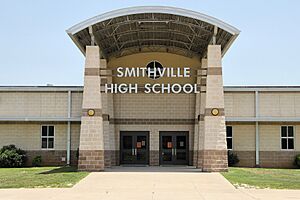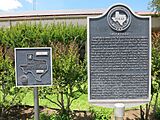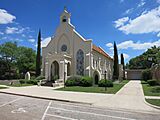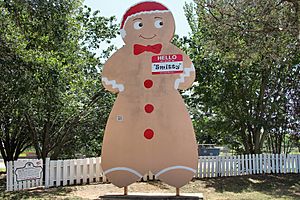Smithville, Texas facts for kids
Quick facts for kids
Smithville, Texas
|
|
|---|---|
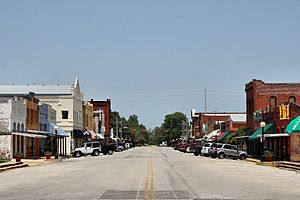
Main Street
|
|
| Nickname(s):
Heart of the Megalopolis
|
|
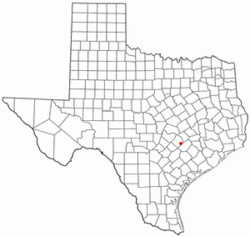
Location of Smithville, Texas
|
|
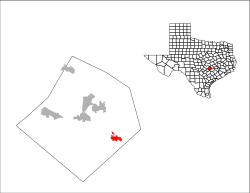 |
|
| Country | United States |
| State | Texas |
| County | Bastrop |
| Incorporated | 1895 |
| Area | |
| • Total | 4.02 sq mi (10.40 km2) |
| • Land | 4.00 sq mi (10.35 km2) |
| • Water | 0.02 sq mi (0.05 km2) |
| Elevation | 325 ft (99 m) |
| Population
(2020)
|
|
| • Total | 3,922 |
| • Density | 1,130.16/sq mi (436.32/km2) |
| Time zone | UTC-6 (Central (CST)) |
| • Summer (DST) | UTC-5 (CDT) |
| ZIP code |
78957
|
| Area code(s) | 512, 737 |
| FIPS code | 48-68456 |
| GNIS feature ID | 2411912 |
Smithville is a friendly city located in Bastrop County, Texas. It's close to the Colorado River. In 2020, about 3,922 people lived there.
Contents
A Look at Smithville's Past
How Smithville Began
The story of Smithville started in 1827 when Thomas Jefferson Gazley arrived. He built the very first house and opened the first store. This store was important for new settlers coming to the area.
Gazley was a true Texas hero. He worked for the Mexican government and helped write the Texas Declaration of Independence. He also helped create the first Constitution for Texas.
Early Families and the City's Name
Later, the William Smith family moved to the area. They also owned a store and helped shape the community. About seventeen families lived on the south bank of the Colorado River. The town was named Smithville because of the Smith family's influence.
The Railroad Arrives
A local businessman, Murray Burleson, convinced the railroad to build a station here. The TB&H railroad arrived in 1887. In 1891, another company, the Missouri, Kansas & Texas (MK&T), took over the railroad.
In 1894, the MK&T built its main repair shops in Smithville. This brought many new jobs and people to the town. For almost 50 years, Smithville became the largest town in Bastrop County.
Growing into a Thriving Town
As more people moved in, Smithville grew from a small village into a busy town. New homes, stores, and other businesses were built. The Hill family started the first bank and retail businesses.
The Buescher brothers helped create the town's first utility systems, like water and electricity. Many important people worked together to build cotton gins, general stores, and drugstores. They also built churches and community groups like the Masons.
In 1895, Smithville officially became an incorporated city.
Smithville's Location and Weather
Smithville is in the southeastern part of Bastrop County. It is about 12 miles southeast of Bastrop. The city is also about 42 miles southeast of Austin.
Smithville's Climate
| Climate data for Smithville, Texas | |||||||||||||
|---|---|---|---|---|---|---|---|---|---|---|---|---|---|
| Month | Jan | Feb | Mar | Apr | May | Jun | Jul | Aug | Sep | Oct | Nov | Dec | Year |
| Record high °F (°C) | 88 (31) |
91 (33) |
98 (37) |
99 (37) |
99 (37) |
100 (38) |
102 (39) |
104 (40) |
108 (42) |
100 (38) |
91 (33) |
90 (32) |
107 (42) |
| Mean daily maximum °F (°C) | 60 (16) |
65 (18) |
74 (23) |
76 (24) |
82 (28) |
87 (31) |
92 (33) |
93 (34) |
91 (33) |
84 (29) |
76 (24) |
61 (16) |
95 (35) |
| Mean daily minimum °F (°C) | 40 (4) |
46 (8) |
57 (14) |
65 (18) |
70 (21) |
72 (22) |
77 (25) |
79 (26) |
72 (22) |
64 (18) |
56 (13) |
32 (0) |
59 (15) |
| Record low °F (°C) | 4 (−16) |
12 (−11) |
14 (−10) |
30 (−1) |
43 (6) |
50 (10) |
59 (15) |
54 (12) |
47 (8) |
22 (−6) |
10 (−12) |
3 (−16) |
3 (−16) |
| Average precipitation inches (mm) | 1.71 (43) |
2.65 (67) |
5.51 (140) |
6.2 (160) |
5.38 (137) |
7.46 (189) |
0.84 (21) |
0.68 (17) |
1.83 (46) |
3.22 (82) |
3.10 (79) |
9.60 (244) |
57.59 (1,463) |
| Source: weather.com | |||||||||||||
Smithville covers about 3.5 square miles of land. A very small part, about 0.04 square miles, is water.
Major Roads in Smithville
 SH 71
SH 71 Loop 230
Loop 230 FM 2571
FM 2571 FM 153
FM 153 FM 2104
FM 2104 SH 95
SH 95
Who Lives in Smithville?
| Historical population | |||
|---|---|---|---|
| Census | Pop. | %± | |
| 1890 | 616 | — | |
| 1900 | 2,577 | 318.3% | |
| 1910 | 3,167 | 22.9% | |
| 1920 | 3,204 | 1.2% | |
| 1930 | 3,296 | 2.9% | |
| 1940 | 3,100 | −5.9% | |
| 1950 | 3,379 | 9.0% | |
| 1960 | 2,933 | −13.2% | |
| 1970 | 2,959 | 0.9% | |
| 1980 | 3,470 | 17.3% | |
| 1990 | 3,196 | −7.9% | |
| 2000 | 3,901 | 22.1% | |
| 2010 | 3,817 | −2.2% | |
| 2020 | 3,922 | 2.8% | |
| U.S. Decennial Census | |||
In 2020, the city had 3,922 people living there. There were 1,711 households and 1,088 families.
The population includes people from many different backgrounds. Most residents are White, with significant Black or African American and Hispanic or Latino communities. There are also smaller groups of Asian, Native American, and mixed-race people.
Learning in Smithville
Smithville has its own school system, the Smithville Independent School District. Students attend Smithville High School, where the sports teams are called the Tigers.
For students who want to continue their education, Austin Community College has a campus nearby in Elgin. Also, the city of Austin is about 40 miles away and has several large universities.
Fun Places to Visit
- The Smithville Visitor Center is a great place to start. It's also home to the James H. Long Railroad Museum and the Chamber of Commerce. You can see exhibits and old items from Smithville's railroad history.
- The Smithville post office has a special painting inside called The Law, Texas Rangers. This mural was painted in 1939 by Minette Teichmueller. It was part of a government program that hired artists to create public artworks during the 1930s.
In 2018 and 2019, new public murals were added in Smithville. These murals show important events from the city's past and honor local leaders.
Famous People from Smithville
Many interesting people have connections to Smithville:
- Bettye Caldwell, an educator
- Thomas Carter, an actor and award-winning director
- Hannibal Lokumbe (also known as "Hannibal"), a jazz trumpeter and composer
- Balor Moore, a major league baseball pitcher
- Sonny Rhodes, a blues singer and lap steel guitar player
- DJ Screw (Robert Earl Davis Jr.), a hip hop artist who was born in Smithville
Smithville's Guinness World Record
On December 2, 2006, Smithville made history! During its 16th Annual Festival of Lights, the city broke a Guinness World Record. They created the world's largest gingerbread man.
This giant gingerbread man was over 20 feet long and weighed an amazing 1308.5 pounds! It took 750 pounds of flour, 49 gallons of molasses, and 72 dozen eggs to make him. The huge pan used for baking is now a monument at the James H. Long Railroad Park.
Another city in Norway has since broken this record.
See also
 In Spanish: Smithville (Texas) para niños
In Spanish: Smithville (Texas) para niños


